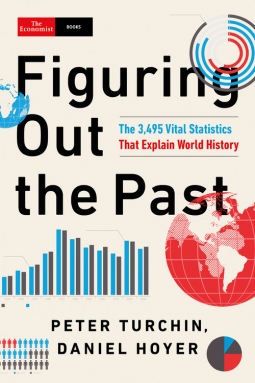So many empires. [Figuring Out the Past by Peter Turchin; Daniel Hoyer]
Discover the world records that define our history and jump headfirst into the past using scientific data that reveals accurate and insightful answers to life’s biggest questions.
What was history's biggest empire? Or the tallest building of the ancient world? What was the plumbing like in medieval Byzantium? The average wage in the Mughal Empire? Where did scientific writing first emerge? What was the bloodiest ever ritual human sacrifice?
We are used to thinking about history in terms of stories. Yet we understand our own world through data: cast arrays of statistics that reveal the workings of our societies. In Figuring Out the Past, radical historians Peter Turchin and Dan Hoyer dive into the numbers that reveal the true shape of the past, drawing on their own Seshat project, a staggeringly ambitious attempt to log every data point that can be gathered for every society that has ever existed. This book does more than tell the story of humanity: it shows you the big picture, by the numbers.
In October 2020 I saw a TikTok that has since changed my life, my outlook on the world. I saw a TikTok about GeoGuessr, a geography guessing game I had no idea about at the time but have since become obsessed with. Why am I talking about this geography game? Because my newfound appreciation for geographical sleuthing has reaffirmed a general love of history and linguistics. On the cake of sociolinguistics that is my gameplay, Peter Turchin and Daniel Hoyer's Figuring Out the Past: The 3,495 Vital Statistics that Explain World History would be chocolate shavings - I could have done without it but it has made the experience so much more enjoyable.
Divided into historical periods, selected societies were profiled. Descriptive blurbs describing respective societal inception and decline were followed by statistics relating size, demographics, governance and societal outlooks. Statistics were presented in an easy to read, digestible format. I appreciated the blurbs, reading the book in order. They contextualized preceding, concurrent, and subsequent historical events, which considering not every preceding and succeeding society was profiled. The book finishes with thematic rankings and maps showcasing historical tendencies.
You can't make or read a history reference text without acknowledging the intrinsic biases of Western historical records. Pre-colonial American and African histories are unknown, underknown, and/or underrepresented. Whether that's to be attributed to known and imagined migration histories or the lasting legacy of genocides, who knows. And so this book focuses heavily on Asian, European, and North African histories as they all intermingled.
But I learned a lot. So many empires fallen, so many names only on record. Such is the nature of civilization I suppose. And while I learned a great deal, as a reference I found this book lacking. With regards to the electronic early copy I received, the references and works cited are nonexistent. As a reference, this might be a quick summary starting point for further learning, but as in my concurrent Google searches, if you came across a new to you name of a society or peoples you'd be hard-pressed to find a solid reference, falling into an information hole. 4 stars from me.
Figuring Out the Past (ISBN: 9781541762688) was published November 2020.

Comments
Post a Comment